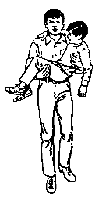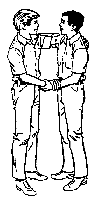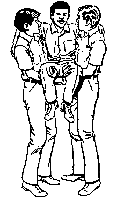Assisting Persons with Disabilities in an Emergency
Introduction
As members of a community here at Swarthmore, we might all be called upon to help other members of the community or visitors with a variety of disabilities, either permanent or temporary. These are some easy-to-remember tips about how to offer help, and specifics for helping in the event of an emergency.
Blindness or Visual Impairment
When assisting a blind or visually impaired person there are some basic rules to follow in order to be effective.
- Announce your presence; speak out when entering the room.
- Speak naturally and directly to the individual and NOT through a third party. Do not shout.
- Don't be afraid to use words like "see," "look," or "blind."
- Offer assistance but let the person explain what help is needed.
- Describe the action to be taken in advance.
If leading someone:
- Let them grasp your arm or shoulder lightly, for guidance. He/she may choose to walk slightly behind you to gauge your body reactions to obstacles; be sure to mention, stairs, doorways, narrow passages, ramps, etc.
- Never "move" the blind person, or touch or move their cane.
- When guiding to a seat, place the person's hand on the back of the chair.
- If leading several people with visual impairments at the same time, ask them to hold each other's hands.
Exiting a building in emergency
- You should ensure that after exiting the building that individuals with impaired vision are not "abandoned" but are led to a place of safety, where a colleague(s) or friend should remain with them until the emergency is over.
Suggestions When Assisting Owners of Guide Dogs
- Do not pet or offer the dog food without the permission of the owner.
- When the dog is wearing its harness, he is on duty; if you want the dog not to guide its owner, have the person remove the dog's harness.
- Plan for the dog to be evacuated with the owner.
- In the event you are asked to take the dog while assisting the individual, it is recommended that you (the helper) hold the leash and not the dog's harness.
Hearing Impairments
When assisting persons with hearing impairments here are some things to keep in mind, including:
- Flick the lights when entering the room to get the person's attention.
- Establish eye contact with the individual, even if an interpreter is present.
- Face the light, do not cover or turn your face away, or chew gum.
- Use facial expressions and hand gestures as visual cues.
- Check to see if you have been understood and repeat if necessary.
- Offer pencil and paper. Write slowly and let the individual read as you write. In an emergency, written communication may be especially important if you are unable to understand the individual's speech.
- Do not allow others to interrupt or joke with you while conveying emergency information.
- Be patient, the individual may have difficulty comprehending the urgency of your message.
- In an emergency, if possible, provide the individual with a flashlight for signaling their location in the event that they are separated from the rescuing team or buddy and to facilitate lip-reading in the dark.
Mobility lmpairments
Always check to see what kind of help is needed, for instance, someone using a crutch or a cane might be able to negotiate stairs independently. One hand is used to grasp the handrail, the other hand is used for the crutch or cane. Here, it is best not to interfere with this person's movement. You might be of assistance by offering to carry the extra crutch while exiting.
- In an emergency evacuation situation, stairways and halls can be crowded, if so, you can act as a buffer and "run interference."
Wheelchair transfers
- Wheelchair users are trained in special techniques to transfer from one chair to another. Depending on their upper body strength, they may he able to do much of the work themselves. If you assist a wheelchair user, avoid putting pressure on the person's extremities and chest. Such pressure might cause spasms, pain and even restrict breathing.If you have to lift a wheelchair user out of their chair to carry them, please be aware that carrying someone slung over your shoulders (like the "fireman's carry") is like sitting on their chest and poses danger for several individuals who fall within categories of neurological and orthopedic disabilities.
Better techniques are:
The Cradle Lift
The cradle lift, the preferred method when the person to be carried has little or no arm strength. It only works if the person being carried weighs less than the carrier's weight. Place your arms under the victim's knees and around their back.

The Packstrap Method
When disabilities make the firefighter carry unsafe, the packstrap method is better for longer distances than the cradle lift:
- Place both the victim's arms over your shoulders.
- Cross the victim's arms, grasping the victim's opposite wrist.
- Pull the arms close to your chest.
- Squat slightly and drive your hips into the victim while bending slightly at the waist.
- Balance the load on your hips and support the victim with your legs.

Two-Person Carry Technique - The Swing or Chair Carry
- Carriers stand on opposite sides of the individual
- Take the arm on your side and wrap it around your shoulder.
- Grasp your carry partner's forearm behind the person in the small of the back.

- Reach under the person's knees to grasp the wrist of your carry partner's other hand.
- Both carry partners should then lean in, close to the person, and lift on the count of three.
- Continue pressing into the person being carried for additional support in the carry.

Other Impairments
Pregnancy
Not usually considered a disability, it can result in reduced stamina or impaired mobility, especially in negotiating stairs in an evacuation. In these cases, offer to walk with the woman and be of support both emotionally and physically. Remain with her until you have reached safety and she has a safe, warm place to sit.
Respiratory Disorders
With respiratory disorders, such as asthma or emphysema, the onset of symptoms can be triggered by stress, exertion, or exposure to small amounts of dust or smoke. Remind the individual to bring inhalation medication when evacuating.
Cardiac conditions
Persons with cardiac conditions, should be reminded to take their medications when evacuating. Offer them assistance in walking; they may have reduced stamina and require frequent rest periods.



